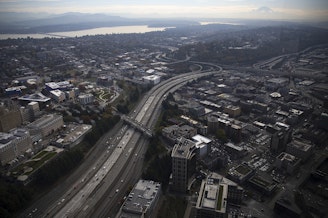Before protest hashtags, there was the WTO and Indy Media

Twenty years ago this month, tens of thousands of activists flooded Seattle to protest the World Trade Organization.
No demonstrations since in this city have come close to the level of violence that ensued.
From those protests was how wield a brand new technology: the Internet.
In November 1999, Danielle Chynoweth came to Seattle with puppets.
Big paper puppets that sit on somebody's shoulders. She was with a street theater group.
What Chynoweth did not bring with her was a smartphone — because they didn't exist.
"This was pre-cellphone for a lot of folks," Chynoweth said. "There was no social media."
This was 1999. Activism was still analog. But they did have a plan: Block delegates from entering the conference and talk with them. Also to not clash with the police.
Sponsored
Chynoweth said they didn't want to do just one march that could be easily broken up. Instead they decentralized and divided Seattle up into sections.
"We broke this city up into I believe it was 18 or 20 pie pieces; I still have the drawing in my journal, actually," Chynoweth said.
"Each pie piece got together, decided its approach and tactic for kind of holding down that intersection so that there was a really the ability to infiltrate."
The first day of the conference, protesters took to the streets outside the convention center. Little violence broke out and few people were arrested.
Stephanie Guilloud, who was with the Direct Action Network, says they had expected mass arrests.
Sponsored
"By the end of that night, we we felt like we were winning," Guilloud said.
That feeling changed, Guilloud said, because the activistswere not prepared for how law enforcement responded.
"The riot gear itself, the tanks, and the martial law," Guilloud said.
Seattle police used billy clubs, tear gas, and pepper spray to try and disperse the crowds.
Chynoweth said she was traumatized for years by what she saw. "I saw a friend pepper sprayed and they snapped her mask back onto her face, so the pepper spray was contained inside her mask," she said.
Sponsored
Protesters responded by smashing windows and spraying painted cars and store fronts. Downtown Seattle devolved into chaos.
But beyond the tear gas and smashed windows something new was happening: Activists were posting what they saw to the internet in real time.
"Folks were bringing in media content and stories and photos and videos and uploading them to this website," she said, "and I was like, 'what is this thing they're doing?'"
That website — the Independent Media Center — immediately spread information from the ground without relying on traditional news media. Today that's called tweeting and live-streaming.
"There wasn't even the same level or scale of email, much less cell phones and that kind of communication," said Guilloud.
Sponsored
Guilloud and Chynoweth said documenting and sharing scenes from the protest was key to controlling their messaging.
Tyna Ek, president of the liberal activist group Seattle Indivisible, said organizers today can reach the general public, not just other activists.
"There are a lot of people organizing now who five years ago wouldn't have dreamed of doing so," Ek said.
Stephanie Guilloud said she sees this with youth movements like March For Our Lives and the Climate Strike.
High schoolers who may have never cared for politics are now engaged and they have the tools to organize and stay in touch in the field.
Sponsored
"Young people are coming together and really saying enough is enough," Guilloud said. "But we're also saying this is the plan and this is what we want."




